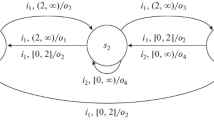Abstract
The paper considers the problems of checking the existence and synthesis of synchronizing and homing sequences for finite input/output automata. The relevant sequences can be used when identifying the state of the system under consideration after applying the proper input sequence. In the model considered in the study, the actions are divided into inputs and outputs, however, there are no explicitly specified sets of initial and final states. The article defines the concepts of synchronizing and homing sequences and suggests methods for their synthesis for a special class of input/output automata, which have transitions in each state on either input or output actions; in addition, there are no cycles marked with output symbols in the corresponding transition graph. The necessary and sufficient conditions of existence of synchronizing and homing sequences are established, and the length of such sequences is estimated for the described class of input/output automata. The subclasses of automata are specified, for which the worst (mainly, exponential) complexity cases are not reachable.



Similar content being viewed by others
Notes
Thus, automata without non-observable actions and without specification of the sets of the initial and final states are considered in this article.
REFERENCES
Martyugin, P.V., Lower bounds for the length of the shortest carefully synchronizing words for two- and three-letter partial automata, Diskretn. Anal. Issled. Oper., 2008, vol. 15, no. 4, pp. 44–56.
Gill, A., State-identification experiments in finite automata, Inf. Control, 1961, vol. 4, pp. 132–154.
Martyugin, P., Computational complexity of certain problems related to carefully synchronizing words for partial automata and directing words for nondeterministic automata, Theory Comput. Syst., 2014, vol. 54, no. 2, pp. 293–304.
Hierons, R.M., Jourdan, G.V., Ural, H., and Yenigün, H., Using adaptive distinguishing sequences in checking sequence constructions, Proc. of the 2008 ACM symposium on Applied computing (SAC), 2008, pp. 682–687.
Ito, M. and Shikishima-Tsuji, K., Some results on directable automata, in Theory Is Forever: Essays Dedicated to Arto Salomaa on the Occasion of His 70th Birthday, Berlin, Heidelberg: Springer; Lect. Notes Comput. Sci., 2004, vol. 3113, pp. 125–133.
Kohavi, Z., Switching and Finite Automata Theory, New York: McGraw-Hill, 1978.
Kushik, N., El-Fakih, K., Yevtushenko, N., and Cavalli, A.R., On adaptive experiments for non-deterministic finite state machines, Int. J. Software Tools Technol. Transfer, 2016, vol. 18, no. 3, pp. 251–264.
Kushik, N., López, J., Cavalli, A.R., and Yevtushenko, N., Improving protocol passive testing through ‘gedanken’ experiments with finite state machines, Proc. 2016 IEEE International Conference on Software Quality, Reliability and Security (QRS), 2016, pp. 315–322.
Kushik, N., El-Fakih, K., and Yevtushenko, N., Preset and adaptive homing experiments for nondeterministic finite state machines, Implementation and Application of Automata. CIAA 2011; Lect. Notes Comput. Sci., 2011, vol. 6807, pp. 215–224.
Kushik, N. and Yevtushenko, N., On the length of homing sequences for nondeterministic finite state machines, Implementation and Application of Automata. CIAA 2013; Lect. Notes Comput. Sci., 2013, vol. 7982, pp. 220–231.
Lee, D. and Yannakakis, M., Testing finite-state machines: State identification and verification, IEEE Trans. Comput., 1994, vol. 43, no. 3, pp. 306–320.
Moore, E.F., Gedanken-experiments on sequential machines, in Automata Studies (Annals of Mathematical Studies), Princeton University Press, 1956, pp. 129–153.
Sandberg, S., Homing and synchronizing sequences, in Model-Based Testing of Reactive Systems; Lect. Notes Comput. Sci., 2005, vol. 3472, pp. 5–33.
Tretmans, J., Test generation with inputs, outputs and repetitive quiescence, Software—Concepts Tools, 1996, vol. 17, no. 3, pp. 103–120.
Volkov, M.V., Synchronizing automata and the Černý conjecture, Language and Automata Theory and Applications. LATA, 2008; Lect. Notes Comput. Sci., 2008, vol. 5196, pp. 11–27.
Kushik, N.G., Yevtushenko, N.V., Burdonov, I.B., and Kossatchev, A., S, Synchronizing and homing experiments for input/output automata, Syst. Inf., 2017, no. 10, pp. 1–9.
Yenigün, H., Yevtushenko, N., and Kushik, N., The complexity of checking the existence and derivation of adaptive synchronizing experiments for deterministic FSMs, Inf. Process. Lett., 2017, vol. 127, pp. 49–53.
ACKNOWLEDGMENTS
The work was partially supported by the Russian Science Foundation (RSF), project No. 16-49-03012 and by the Russian Foundation for Basic Research, project No.17-07-00682.
Author information
Authors and Affiliations
Corresponding authors
Additional information
Translated by Yu. Bezlepkina
About this article
Cite this article
Kushik, N.G., Yevtushenko, N.V., Burdonov, I.B. et al. Deriving Synchronizing and Homing Sequences for Input/Output Automata. Aut. Control Comp. Sci. 52, 589–595 (2018). https://doi.org/10.3103/S0146411618070167
Received:
Published:
Issue Date:
DOI: https://doi.org/10.3103/S0146411618070167




